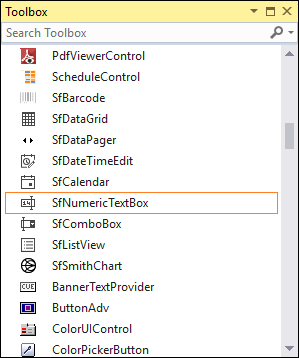Getting Started with Windows Forms Numeric TextBox (SfNumericTextBox)
12 Dec 20258 minutes to read
This section briefly describes how to create a new Windows Forms project in Visual Studio and add SfNumericTextBox with its basic functionalities.
Assembly deployment
Refer to the Control Dependencies section to get the list of assemblies or details of NuGet package that needs to be added as reference to use the control in any application.
Refer to NuGet Packages to learn how to install nuget packages in a Windows Forms application.
Adding SfNumericTextBox control via designer
The following steps describe how to create a SfNumericTextBox control via designer:
-
Create a new Windows Forms application in Visual Studio.
-
Add the SfNumericTextBox control to an application by dragging it from the toolbox to design view. The following dependent assemblies will be added automatically:
- Syncfusion.Core.WinForms
- Syncfusion.SfInput.WinForms
- Syncfusion.Shared.Base

Adding SfNumericTextBox control via code
-
Create a C# or VB application via Visual Studio.
-
Add the following assembly references to the project:
- Syncfusion.Core.WinForms
- Syncfusion.SfInput.WinForms
- Syncfusion.Shared.Base
-
Include the required namespace.
Using Syncfusion.WinForms.Input;Imports Syncfusion.WinForms.Input
4) Create an instance of SfNumericTextBox, and then add it to the form.
private Syncfusion.WinForms.Input.SfNumericTextBox numericTextBox = new Syncfusion.WinForms.Input.SfNumericTextBox();
this.numericTextBox.Size = new System.Drawing.Size(150, 20);
this.Controls.Add(this.numericTextBox);Private numericTextBox As Syncfusion.WinForms.Input.SfNumericTextBox = New Syncfusion.WinForms.Input.SfNumericTextBox()
Me.numericTextBox.Size = new System.Drawing.Size(150, 20)
Me.Controls.Add(Me.numericTextBox)Value
SfNumericTextBox holds double value, and it can also hold null value. The AllowNull property needs to be set to make the value nullable. The Text property of the control is formatted from the Value property.
// To set the value to SfNumericTextBox.
this.numericTextBox.Value = 123.45;‘ To set the value to the SfNumericTextBox.
Me.numericTextBox.Value = 123.45
Format types
The string formatting is replacement of string in specified string format. Based on the string formatting, the numbers can be formatted into the following three different modes:
- Numeric
- Percent
- Currency
These modes can be applied in SfNumericTextBox using the FormatMode property. By default, the FormatMode is set to Numeric.
// To set the format mode to Numeric.
this.numericTextBox.FormatMode = Syncfusion.WinForms.Input.Enums.FormatMode.Numeric;
// To set the format mode to Currency.
this.numericTextBox.FormatMode = Syncfusion.WinForms.Input.Enums.FormatMode.Currency;
// To set the format mode to Percent.
this.numericTextBox.FormatMode = Syncfusion.WinForms.Input.Enums.FormatMode.Percent;' To set the format mode to Numeric.
Me.numericTextBox.FormatMode = Syncfusion.WinForms.Input.Enums.FormatMode.Numeric
' To set the format mode to Currency.
Me.numericTextBox.FormatMode = Syncfusion.WinForms.Input.Enums.FormatMode.Currency
' To set the format mode to Percent.
Me.numericTextBox.FormatMode = Syncfusion.WinForms.Input.Enums.FormatMode.Percent
Formatting the value
The formatting functionality allows to format the values based on the FormatMode of the control. By default, the value is parsed from the application’s CurrentUICulture. Custom formatting can also be done using the NumberFormatInfo property, which allows to set decimal separator, group separator, negative symbol, number of decimal digit, currency symbol, and percent symbol.
this.numericTextBox.NumberFormatInfo = new CultureInfo("de-DE").NumberFormat;Me.numericTextBox.NumberFormatInfo = New CultureInfo("de-DE").NumberFormat
NOTE
The SfNumericTextBox control preserves the full precision of the assigned value in its Value property while displaying the formatted value in the text box. This ensures that you can use the exact value for future calculations without losing accuracy. While editing, the Value property will be updated based on the current value in the textbox.

Watermark
SfNumericTextBox comes with the in-built watermark support. WatermarkText helps to display the details about what value need to enter. WatermarkText property allows to show the watermark for the control when the value of the control is set to null.
// Sets the watermark text to SfNumericTextBox.
this.numericTextBox.WatermarkText = "Enter your age";
// Sets true to AllowNull property
this.numericTextBox.AllowNull = true;' Sets the watermark text to SfNumericTextBox.
Me.numericTextBox.WatermarkText = "Enter your age"
' Sets true to AllowNull property
Me.numericTextBox.AllowNull = True
Minimum and maximum values
We can define the range of value which can be accept by the control. To define this range, we need to provide minimum possible value and maximum possible value using the property MinValue and MaxValue respectively.
// Sets the minimum and maximum values
this.numericTextBox.MinValue = 10;
this.numericTextBox.MaxValue = 150;‘ Sets the minimum and maximum values
Me.numericTextBox.MinValue = 10
Me.numericTextBox.MaxValue = 150Hiding the trail zeros
The trailing zeros after the decimal digit can be removed using the HideTrailingZeros property.
// Hides the trailing zeros.
this.numericTextBox.HideTrailingZeros = true;' Hides the trailing zeros.
Me.numericTextBox.HideTrailingZeros = True
Custom units
Set units or custom message at front or end of the text using the Prefix and Suffix properties.
// Sets the custom unit in SfNumericTextBox.
this.numericTextBox.Suffix = "inches";' Sets the custom unit in SfNumericTextBox.
Me.numericTextBox.Suffix = "inches";